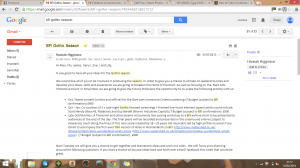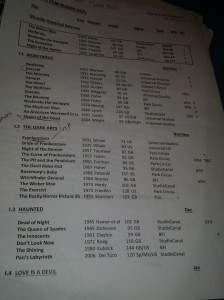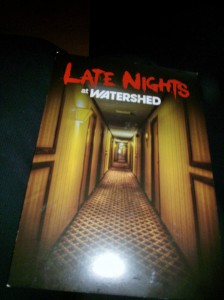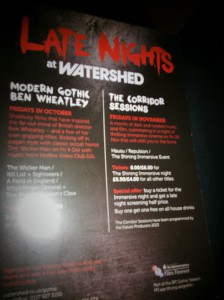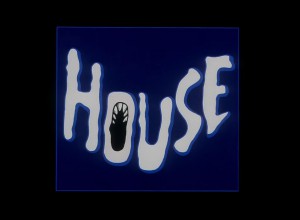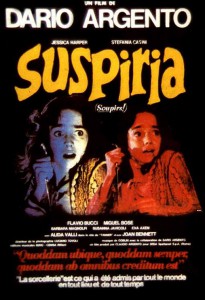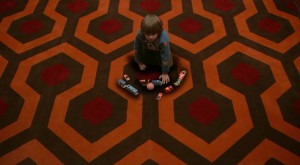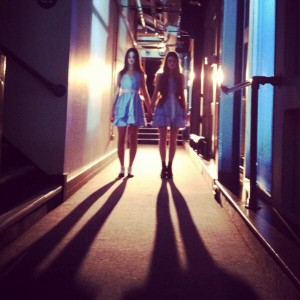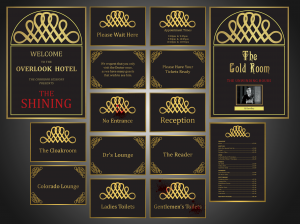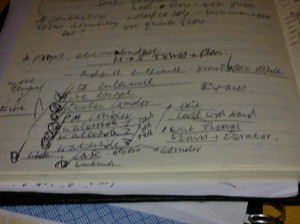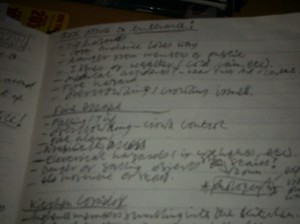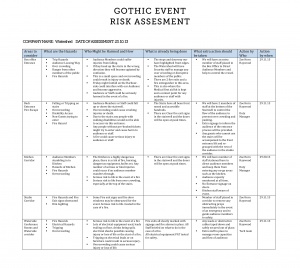After the presentation I gave in July proposing my desire to be involved in the Future Producer’s team working on Watershed’s BFI Gothic: The Dark Heart of Cinema Season, (details of the presentation and original pitch and ideas can be found at blog) to well, the aftermath where the event ended just over two months ago, I find myself reflecting back with great pride on what our team accomplished. I am also feeling pretty great about my own contributions towards the main event of our season, the immersive cinema event that over the weeks leading up to the event was chopped, changed, stripped back, scrutinized, simplified and evolved into what became…well let’s start at the beginning!
The Brief:
Our brief was to create an Immersive Dark Arts cinema event at the end of November were for one night the Watershed would be turned into a unique, chilling Gothic pre-screening experience based around the film of our choice that would attract Watershed non-attenders between 18-25 to come see a film in their cinema and learn what the Watershed is all about. With the support of our co-curators, Compass Presents, a group known for their immersive/expanded cinema and theatre, we were asked to make the event an interactive experience that would play with our audiences emotions in a way that would make them feel like they were taking part in the film, in a similar vain to Future Cinema.
However, added into our brief were a few more surprises. Our immersive cinema event could become the grand finale of the Watershed’s extended BFI Gothic Season which we include in the lead up to the event three late night Gothic film screenings, that we would co-curate a music workshop based around scoring a soundtrack to a silent Gothic short film. For the team this gave us a lot to think about and there were a lot of voices.
The Team:
We were a seven person team, the largest of the Future Producer groups. Seven of us including myself who came from a wide range of backgrounds and interests with a few bucketfuls of ideas each and who in the end managed different aspects of our immersive cinema event. In total our team included three designers, a director, a photographer and an actor.
1) Zoe, a graphic designer whose organisation skills helped drive the projects forward, kept the team together and helped myself co-ordinate evaluations as well as heading marketing and publicity.
2) Flo, a performance enthusiastic printmaker who became our team’s external talent and performers manager.
3) J, a set designer and stage manager who took control over set design, costumes and props.
4) A film director and music/sound enthusiast, Varun who took a lead on helping to curate films for the late night screenings and organising the music and sound effects for the immersive event.
5) Alex, another theatre creative and performance lover who focused on marketing and publicity work with Zoe and aided Flo.
6) Lily, a photographer and fine art student who focused in the beginning of the course by taking a lead on aiding the organisation of the music workshop.
7) And me…with my first responsibility being to oversee Health and Safety and create risk assessments for the immersive cinema event, secondly aiding Zoe with evaluating the success of our events and then later on being the lead on co-ordinating our technical requirements for lighting and aiding Varun to upload our music and sound effects to the Watershed computer system. But more on that later in the next blog!
However, to start with we had the issues of picking and setting in stone our films for both the Gothic immersive event and the late night film screenings which meant a lot of films to watch and not all of them were on the BFI’s Gothic Digital Cinema Package, as you can see below!
Our Audience:
From the start however, one thing we knew and we were always able to come back to…our target audience.
We had knew and were able to do from the start was know how to let young people across Bristol know about our event. Knowing that like ourselves our audience would be young creatives, Bristol arts, interested in pop culture, geek culture, interactive theatre and film-enthusiasts, Gothic lovers or any combination of the previous we between us we knew potential ways to market an event towards. Whether by using the Watershed’s and our own and other Future Producers personal social media links and connections on Twitter and Facebook (the latter where we later created an event page). Likewise we knew possible locations where we could distribute flyers to venues and groups across Bristol from the arts Cafes and bars in Clifton, to theatre and arts venues in the the city centre, Stokes Croft, Bedminster and Southville (my neck of the woods where I flyered) and most importantly, the two universities in Bristol.
Likewise we had at our hands a brilliant marketing team at the Watershed who were able to create a visual stunning flyer for us that also tied in our event with a series of horror late night films curated by acclaimed British horror director Ben Wheatley which would give us another potential market to attract some of our target audience from with fans of horror films. Flyers were also distributed by myself and the team at the end of the Wheatley late night screenings as well as our Gothic screenings.
Picking the Right Films and the Theme:
When it came to picking the film for the immersive screening I and the rest of the team struggled to suggest or find an appropriate film. The problem we had was finding a film that would give appeal to our target audience and would also allow us enough creative freedom and scope to create a layered immersive event with plenty of options for recreating famous scenes that our audience would want to interact with. Not just that but we had to create around the event and the films we picked for the screenings a theme that would sum up the direction of our season.
Eventually, however, one film was suggested that gave us the chance to create the illusive ‘experience’ and emotions we wanted to instill in our audience. One that audience members would know well due to the film’s classic cult following, famous and genre transcending scenes, costume, props and set design (which could be recreated on a budget) and would certainly connect to our core audiences interests and wants for an immersive experience. It also helped us to build the season around a solid theme that is a constant stable of Gothic works of fiction.
The Shining! A film rich in history and still relevant and at the time back in the spotlight due to the release of the Shining’s book sequel, Doctor Sleep and also Jack Nicholson’s retirement from acting. This also lead to the creation of the theme for the entire season; ‘The Corridor Sessions’, as all the films revolve around horrific and ghostly events occurring within the confines of enclosed spaces and corridors. As seen on our flyers below:
This allowed Alex, J and Varun (our designated late screening screening selection team) to pick for the late night screenings to pick three our favourite Gothic films from around the world that all revolved around small, unusual and Gothic spaces with the acid-trip Korean horror film Hausu, Roman Polanski’s British-based psychological thriller Repulsion and Italian witch-based horror Suspiria.
Plans and Installations for the Shining Immersive Event:
We knew from the moment we picked the Shining to build our immersive event around that it was a marketable film that would sell tickets and that our audience would be interested in. We had no doubts or limits to the possible creative set-ups, scenes, pieces of set, props, costume, music, characters we could use to make the audience feel that the Watershed is the Overlook Hotel.
Given our budget also we believed it would be workable to even at it’s most basic and stripped back re-create the basic aspects of the Overlook’s motif, in particular the classic and most memorable parts of its interior like the pattern carpet which we could re-create using the projectors and video screens to display on walls around our selected spaces.
Likewise given the minimum nature of the corridors and sets within the film we knew that however we chose to create set-pieces or moments from the film with props like typewriters, a tricycle and photographs would be attainable and not majorly expensive as that the set.
The main issue we knew we would have to resolve and that caused some headaches during decision times was what set-pieces and installations we would use and focus on and would be enough to engage and emotional influence our audience during the pre-screening period in the Waterside spaces.
To make the project work we knew we would have to not only sell tickets but interest our audience during the 1-2 hours they would have in the Watershed before the screening and that to make those non-attenders revisit the venue we had to give them effort options and engaging possibilities to keep them and the 100 or so other guests entertained.
We would know if the project would work based on the collection of installations we acquired or created and if this satisfied and entertained the majority of our audience.
This took sometime and there were a lot of ideas suggested. This for example is an early draft of all the ideas that had been suggested by others that I collected together into a document, along with my own creative possibilities for the evening. 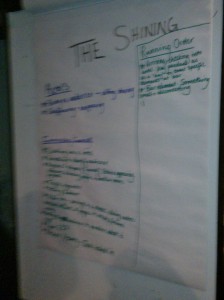
With the aid of Compass Presents and the Watershed’s Cinema Programme Producer, Maddy Probst and based off of Zoe’s and Flo’s research and suggestions we were able to narrow down our options.
Timeline for the Shining Event:
After a lot of debating, cutting and support from our co-curators Compass Presents we stripped down our ideas for the The Shining Immersive Evening to the following:
Before the event the audience were sent in advance an emailed with a welcome letter written by the hotel manager wishing them a pleasant stay and informing them about the 1920’s dress code for the night’s festivities.
On the night the audience arrived in groups at ten-minute intervals (organised based on their replies to the aforementioned email) to collect their tickets from the Watershed’s Front of House desk and then were told to make their way to the guest’s entrance (the fire escape route at the back of the building) around the corridor.
At the front desk they checked into the hotel and were given a room key. Once the audience group for that time block had arrived one of our two hotel managers took them on a tour through the corridor, past the kitchen and storage room and down a corridor that was blocked off to the public in the next door Watershed Cafe bar towards the Waterside 2 that served as our Gold Room.
The managers gave a speech on the history of the hotel on this tour and just before arriving at the Gold Room the sounds of ferocious and vicious banging would be heard from a near-by cupboard where I was stationed to acting like someone who had been looked in their (another nod to the film).
The audience were then rushed into Waterside Two were an actor playing a writer was sat trying to work on his latest piece with no luck and who over the course of the course of the night began losing his mind as he interacted with the audience.
In Waterside 3, our decorated Gold Room the audience were given the freedom to put their bags and clothes in storage, buy drinks from the mobile bar and interact with several of the interactive pieces and events set up in Waterside 3 and in the connecting corridor that lead to Waterside 1. They had all the time before the 11PM screening to explore the spaces and installations.
These interactive pieces in Waterside 3 included a telecommunications system, given to us by Compass Presents where the audience could talk with Varun in a weird series of ghostly conversations, a photo-booth were audience members could have their pictures taken posing with an ax with their faces poking through a broken wooden door.
In Waterside 3 we also had one of the Watershed’s magicians in residents sat in doctor’s cubicle giving readings on which characters in the Shining they are most like and performing mind-reading tricks to individual audience members.
In the connecting corridor there was also an exhibition piece of horogrami of the Overlook Hotel (click here to view) and in Waterside 1 was another the Watershed’s other Magician in Residences who, using the guest’s hotel room keys that they had been given when checking in, tested with larger groups of our audience if anyone possessed the Shining.
At 11 audience members were informed it was almost time for the screening and the volunteers helping to co-ordinate and act as stewards managing and keeping an eye on the different parts of the venue created a line of staff stretching from the darkened and deserted Waterside Cafe to the cinema. The audience walked past a line of blank faced staff on their way to the cinema and some of them who had been looking down the far end of the corridor would have seen these two figures standing with their backs to them.
After the screening the audience exited the cinema and could see the final touches of the evening, a red-soaked filled elevator (posing as an elevator with a river of blood), two dead twins lying at the far end of the corridor and the swing-dancers who opened the after-screening party in the Watershed Cafe bar, which acted as our final nod to the film with it’s 4th July party.
In the Waterside area also several of the movable installations also moved into the space including the photography booth and additionally typewriters for the audience to have a go at writing their own lines. A music playlist designed by Varun played until the end of the night around 2AM when the audience slowly began leaving.
Compared with the ideas that were generated in the development stage:
The Shining Immersive Cinema Night Ideas 2
Sourcing Resources (People, Set, Lights, Costume, Props and More):
For the event a lot of resources were required to put together the immersive night, although the Watershed and Compass Presents were able to help provide some of the things we needed from our budget and from what they had available.
Our budget included money for film fees, hiring of professional musicians for the music workshop and the room hire of the Watershed spaces. The mobile bar we used in our Gold Room belonged to the Watershed and due to Watershed staff being involved on the night selling food and drink this was one thing we did not need to worry about.
Staff for the immersive event and film screenings were either pre-booked and paid for by the Watershed and additional stewards and support for the event we gained through asking other Future Producers or friends who we knew who’d be interested in seeing the Shining screened were roped in as volunteers. Performers for the evening in the form of our managers, twins, writer and dancers were recruited by Flo at either a low cost per person or for free due to knowing the actors. Similiarily with the photographer we would not have to pay for him as he would gain money through getting the audience to pay a small price for the pictures they wanted printed.
To re-create some of the details of the film we required numerous amounts of props to create small details and to create an authentic feel of the hotel. From pictures and picture frames displaying the hotel’s history and guests and medical props for the ‘doctors spaces’, our magicians in residence spaces to notable and ironic aspects of the film like typewriters and a tricycle.
Most of our set and props we were able to borrow from people we knew (typewriters, the door for the photo-booth, a painting of the cigarettes that Jack smokes), the Watershed (sofas, a writer’s desk, screens) or Compass Presents (the telecommunication system, fabrics and coat-hangers for the coat racks). Some items such as the horogami Overlook Hotel we were able to borrow for free after a member of the Watershed staff were able to get it for us on their way back from London. Other props and set like the tricycle were donated to us.
The main props and small decorations that we had to spend money on were for things like buying 300 keys, printing sign-age for the building and labels to attach to the keys, small fake candle lights for tables, extra bits of material to cover the sofas, balloons and other bits of party material. This helped to keep costs down.
In the end we did not need to pay any high-costs for hiring extra lights or sound equipment as the Watershed had the correct technology available and plenty of lights to choose from. Compass Presents were also able to lend us a few lights and we were able to borrow some pieces like the telecommunication system, which came with the necessary cabling and cameras so we would not have to pay for external equipment.
Costumes the stewards were asked to provide by wearing white shirts and smart trousers and shoes, although we did have to pay for about twenty-odd red bow-ties. The dresses for the twins J was able to find in a second hand charity store and the male actors and magicians in residences were able to provide their own clothes.
Music did cost a bit more than expected to purchase for use, but overall the most we had to spend was on fees for the talent.
Health and Safety:
Me at the Watershed’s Health and Safety Workshop with the rest of the Future Producers. I watch attentively and make notes on something I don’t realize I will be in control of soon enough!: 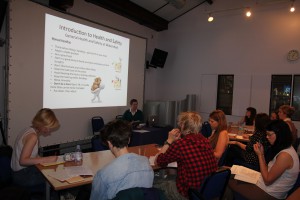
In terms of Health and Safety for the Shining event, I had been present during the Watershed’s Health and Safety workshop during our Future Producers sessions and after taking control of Health and Safety I consulted the Health and Safety Executive government website. I then spent time listing out the potential threats in each different room/space indoors and outdoors that could harm or injury our audience, the public, the Watershed team and ourselves during the course of the night.
The main concerns I noted related to basic health and safety issues such as trip hazards, overcrowding and fire hazards/access and my the notes later would form the basis of our event risk assessment. Later also when I took charge of our technical needs and helped strip down our lighting requirements to a minimum in order to create a darker, more brooding emotional mood within the Watershed’s spaces this also minimized the risk posed by lighting and electronical equipment. However, the obvious issues related to the dimness of lighting were noted and the lighting levels of the spaces and lighting used around potential trip hazards such as our tricycle in a far corner where placed out of the way and were well-lit.
Planning for What Could Have Gone Wrong:
As a team after the BFI approved of our intended Season the main problems we faced was trying to organise and pay for external talent for the event, the photographer, the actors to perform during the pre-screening drinks and organising a band/musicians and dancers for the after-screening party.
Flo was able to secure actors by contacting some of her friends instead of using some more expensive options from a dance and theatre company she had been in contact with.
Yet in the run-up to the event Tara and Charlie, our two mentors from Compass Present had been trying to help us organise for a swing band to play for us after the screening in the Watershed’s cafe bar area. We were not able to offer them as much money as they asked for and in the end we had to go to our back-up plan of playing for the after-screening party a playlist of music Varun had created and Flo was able to acquire some swing dancers from a Bristol-based dance class to perform during this period to provide an extra attraction for the event.
Individually, while organising the technical requirements for the event I had to co-ordinate with Tara from Compass Presents and Ewan, the Projection (technical) Team Manager for the Watershed to simplify our original lighting requirements after discovered that a lot of the types of lights we needed were already in place in the Waterside rooms.
I also had to pose to the rest of the team the potential issue that we might not have been allowed to use Compass Presents’s telecommunication machine due to concern that we would not be able to have a suitable place where we could safety run wires between rooms in the building. However, after putting Tara and Charlie in touch with Ewan and discovering the length and thickness of the cables this crisis was averted.
Feedback
Both myself and Zoe meet to discuss how we would evaluate the success of our event and evaluate whether the how the production process up to that point and the way we had divided up responsibilities amongst the group had been effective.
During this meeting we applied the method we had learnt from Glow Consultant’s Lycia Harper from one of our Future Producer’s workshops, The Story of Change, to decide on behalf of the entire team what how story was and decide who and what were our main beneficiaries and those involved in the production process, including ourselves as a team, our audience, members of the Watershed staff who we worked with and external actors and stewards who took part in the event.
Through creating a list of short questions for each of these groups we felt we would be able to gain feedback that would help the Watershed understand and decide if an event such as an immersive cinema screening could be a potential attraction for non-Watershed attenders between 18-25 and also for ourselves to evaluate and get feedback from all those different individuals who worked with us so we would have feedback on our performances for future event planning.
In the end, however, due to time constraints and realizing that realistically we would not be able to get enough appropriate feedback from every individual who worked with us to produce the project given their busy schedules, we made the choice to focus more on gaining feedback from the audience.
Feedback from the audience was collected through evaluation sheets handed out at the end of the late-night screenings and more event-orientated and related questionnaires were given to audience members to fill in after the Shining Immersive event. We also intended to gain feedback on the night by having a guest book for audience members to sign and where they could put down their un-directed thoughts and feelings about their stay at our version of the Overlook Hotel and through monitoring social media comments on the event’s Facebook page and using Twitter hashtags.
A section of our notes on how we would evaluate our own actions. This went into an email that went unanswered by many of us due to time constraints, other commitments and general lack of time 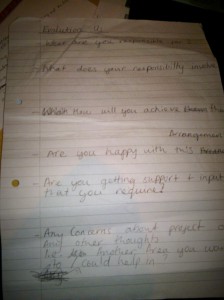
Data collected by the Watershed after the event from social networking sources, questionaires and our guestbook.
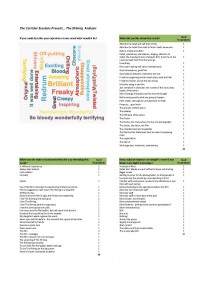
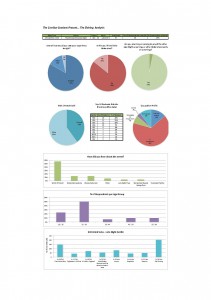
In Part 2 I discuss more about my personal opinions and feelings towards the event, how I felt my leadership skills within the group more specifically came into play and how on the night and since I have learnt that taking a leading role within a production does not have to always be about controlling all parts of the project and how compromise is important.
